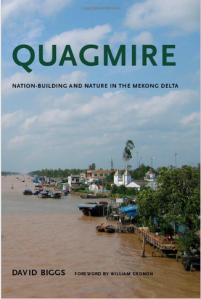Cambodge: The Cultivation of a Nation 1860-1945 Penny Edwards
From Chapter 2: Urban Legend
“Elsewhere in French empire, the spatial and architectural foundation of colonial cities encouraged the possibility of combining modernism and tradition. In Cambodge, colonial architecture and town planning had a reverse effect. By promoting notions of the incompatibility of Khmer and non-Khmer symbols of national, grouped as these were in distinct milieux, they are implicitly segregated notions of antiquity (associated with Angkor and “Khmerness”) from modernity (associated with the French Quarter and the protectorate’s government offices.)
In 1889, a French visitor to Phnom Penh dismissed the colonial capital as a “place of transit”, preempting ethnologist Claude Levi-Strauss’ condemnation of the new Brazilian city of Goiania, some forty years later as a “place of transit – not of residence.” This trope of transience tallied with common colonial castings of indigenous lives and spaces as ephemeral, fleeting, shadowy, and transgressive.
Clear distinctions were made between the indigenously built environment of the “golden age” of Angkor – which was deemed, like one of many twelfth- and thirteenth-century stone structures that has survived, as marking a stage of civilization from which Cambodians had ever since been in a state of flight, like nomad of history who had not yet found a firm footing in firm structures and the present, seen as unanchored, both in its predominate form – flammable wood – and design.
Considering Khmer palaces too makeshift to represent real power, European planners were brought in to supervise the construction of lasting monuments to “majest” in stone, brick, cement and concrete. A primary facet of this transformation was the development of a “national style,” first articulated as such in the national pavilions designed in a presumed “purely Cambodian style” for Europe’s grant nineteenth-century exhibitions.
Like other French colonial cities, Phnom Penh’s emerging geometric cityscape paid tribute to Rene Descartes vision of a “well-ordered” town laid out “on a vacant plane as suits [the engineers] fancy.” Colonial approaches to the city also reiterated notions of an unspoiled rule essence versus a corrupting urbane environment. Constructing a Cambodian quarter was one way of quarantining that quintessential, rural Khmerness, colonial planners inscribed the notion of the vanished Khmer on the very Quartier cambodgien (Cambodian quarter) that they built. The grafting of Angkorean symbols onto the new capital’s streetscape correlated witht he crafting of a new profile for the Khmer monarchy, with the Angkorean undertones and opulent dimensions, through palace construction and ceremonial function that allowed Kind Norodom I and his successors to embody the splendor – but not the substance – of kingship on a scale unseen since the fall of Angkor.”
“In the first two decades of the protectorate, the king retained complete power over the treasury as well as the farming of opium, fisheries, pig farms, gambling and other concessions, and he was the undisputed owner of all land in the kingdom. At Oudung as in previous royal capitals, wood and that housed royalty, mandarins, and peasants, while masonry was generally reserved for temples, reliquary stupas, and funeral monuments. Wood has been used by royalty and peasants alike since at least the third century, and early Chinese accounts note that rulers in the region lived in tiered, wood buildings, while commoners resided in thatched wooden houses raised on stilts, know in French as paillotes. This trend continued after the fall of the Khmer capital at Lovek in 1594, with the construction of the new royal palace at Oudong as a walled compound of wooden buildings. Most elaborate was the house of the queen mother, who remained at Oudong after the transfer of the royal capital to Phnom Penh in 1864.
The quality of building materials – which ranged from bamboo matting and thatch to fine timbers — and craftsmanship varied from one dwelling to another according the the rank and status of their owners. But the location of a residence and its proximity to sacred sites acted as more significant indicators of power and status. Centuries of upheaval, the perennial threat of war and relocation, and indigenous notions of power all ensured that political potency was vested in enduring ceremonial items and human constellations of kin and clientele, both of which could be quickly mobilized, rather than elaborate palace complexes or lavish personal abodes. Displays of power and ways to earn and express merit in the built environment took the form of the construction or renovation of a Buddhist monastery or ancestral temple, hospice or library.”
“In 1884, the French Protectorate, anxious to end its dependence on the king’s gift or loan of land and buildings, dealt a fiscal deathblow to the Cambodian monarchy in the form of a convention that established four categories of property ownership: royal property, public property, inalienable public reserves that could be leased, and inalienable private property. In October 1889, to achieve his goal of “sanitizing, developing, and embellishing” Phnom Penh RSC de Verneville issued a new convention securing the protectorate long-coveted development rights over Phnom Penh, whereby Norodom ceded all land and property rights in Phnom Penh to the protectorate, in exchange for an annual rent of thirty thousand piastres.”
“…RSC de Verneville began work on a canal that flowed into the Tonle Bassac River to form a triangular moat around the French quarter, thus protecting and isolating Phnom Penh’s European population. The resultant landfill transformed large tracts of swampland into the foundations of a future roads and streets…. A new printing house, treasury, pharmacy, customs house, and a new streets completed the capital’s transformation from a rambling morass into a highly segregated and hierarchical city.”
“The city was best known for its vast tracts of mosquito-infested swampland, the stench of stagnant water and human waste, and frequent outbreaks of cholera. In the wet season, boat travel was necessary between different sections of Phnom Penh.”













